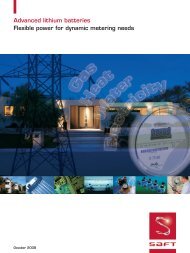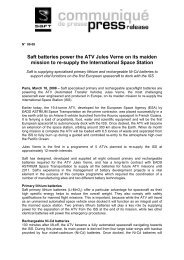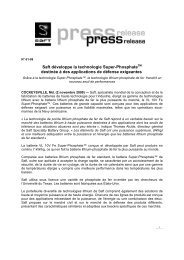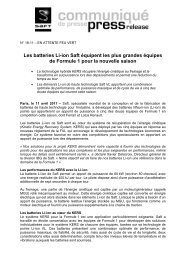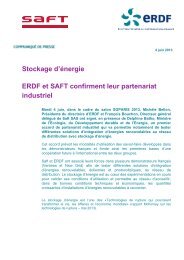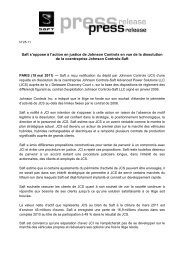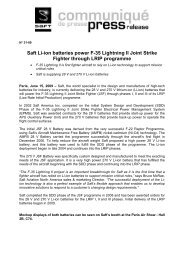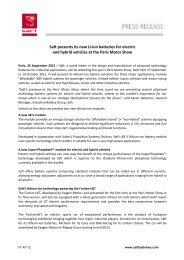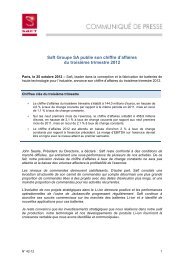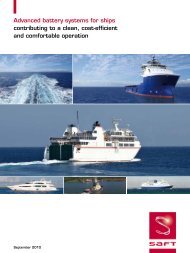ANNUAL REPORT 2011 REGISTRATION DOCUMENT - Saft
ANNUAL REPORT 2011 REGISTRATION DOCUMENT - Saft
ANNUAL REPORT 2011 REGISTRATION DOCUMENT - Saft
You also want an ePaper? Increase the reach of your titles
YUMPU automatically turns print PDFs into web optimized ePapers that Google loves.
6<br />
<strong>2011</strong> CONSOLIDATED FINANCIAL STATEMENTS<br />
Notes to the Consolidated Financial Statements<br />
In accordance with IAS 18 “Revenue recognition”, revenue<br />
from the sale of goods and equipment are recognised when<br />
there is a formal agreement with the customer, the amount<br />
of revenue can be reliably measured, it is probable that the<br />
economic benefi ts associated with the transaction will fl ow<br />
to the Group, and the Group has transferred substantially all<br />
the risks and rewards of ownership to the purchaser. If the<br />
contract requires formal acceptance of the goods, equipment<br />
or services by the customer, revenue recognition is in principle<br />
deferred until the date of such acceptance.<br />
Revenue is measured at the fair value of the consideration<br />
received or receivable. Where payment is deferred and the<br />
effect on fair value is material, this effect is taken into account<br />
by discounting the future payments.<br />
For products sold through distributors, revenue is recognised on<br />
delivery to the distribution network. Product returns, estimated<br />
in accordance with contractual commitments and statistics on<br />
past sales, are recognised at the same date.<br />
Construction contracts<br />
IAS 11 defi nes a “Construction contract” as a contract<br />
specifi cally negotiated for the construction of an asset or<br />
a combination of assets that are closely interrelated or<br />
interdependent in term of their design, technology and function<br />
or their ultimate purpose of use.<br />
Group sales from constructions contracts are primarily for the<br />
construction or design of specifi c batteries, mainly in military<br />
applications and satellites.<br />
In accordance with IAS 11, in recognising revenue and profi ts<br />
on construction contracts the Group applies the percentage of<br />
completion method based on contractually-agreed milestones<br />
(determined on the basis of costs incurred compared with total<br />
estimated contract costs).<br />
Probable losses on completion are recognised immediately.<br />
In the event of uncertainty regarding customer acceptance, or<br />
in the case of relatively short-term contracts, revenue is only<br />
recognised up to the amount of recoverable costs.<br />
Work in process on long-term contracts is recorded at<br />
production cost and does not include any administrative or<br />
selling expenses.<br />
Movements in contract penalties (late delivery or noncompliance)<br />
are recognised as a deduction from revenue.<br />
Partial payments received under construction contracts are<br />
recognised as a liability in the balance sheet under “Prepayments<br />
on long-term contracts” for the portion of such payments<br />
corresponding to work not yet carried out. The amount of costs<br />
incurred, plus recognised gains and less recognised losses (in<br />
particular provisions for losses to completion), is calculated<br />
individually for each contract. If this amount is positive, it is<br />
recorded as an asset under “Long-term contract receivables”.<br />
If negative, it is recorded as a liability under “Prepayments on<br />
long-term contracts”.<br />
2.24 COST OF SALES<br />
Cost of sales mainly includes:<br />
� the cost of production, which includes the acquisition cost<br />
of raw materials and other components used in production,<br />
direct production costs (mainly salaries), and indirect<br />
production costs that are attributable to the production of<br />
the goods sold;<br />
� depreciation of property, plant and equipment and<br />
amortisation of intangible assets;<br />
� depreciation of deferred grants related to assets;<br />
� provisions for product returns; and<br />
� direct selling costs (freight, packaging and sales<br />
commissions).<br />
2.25 GROSS PROFIT<br />
Gross profi t is calculated as net revenue less cost of sales.<br />
2.26 OPERATING PROFIT (LOSS)<br />
Operating profi t is made up of gross profi t, administrative and<br />
selling expenses, Research and Development expenses, other<br />
operating income/expenses and restructuring costs.<br />
Other operating income and expenses consists primarily of:<br />
� gains or losses on forward contracts for purchases and<br />
sales of commodities, where the hedging contracts do not<br />
satisfy the IAS 39 criteria for hedge accounting;<br />
� gains or losses on available-for-sale securities;<br />
� gains or losses on disposals of investments, of property,<br />
plant and equipment, and of intangible assets;<br />
� income and expenses that are non-recurring during the<br />
Group’s day-to-day operations. They are characterised by<br />
their unusual nature and/or amount.<br />
Operating profi t excludes net fi nancial expense and income<br />
tax expense.<br />
2.27 FINANCIAL INCOME AND EXPENSES<br />
Financial income and expenses include interest income and<br />
expense, changes in the fair value of held-for-trading and<br />
available-for-sale fi nancial assets, impairment losses on<br />
other non-current fi nancial assets, foreign exchange gains<br />
and losses, changes in the fair value of fi nancial instruments<br />
(excluding hedges of non fi nancial assets and liabilities) and<br />
other fi nancial income and expenses.<br />
SAFT - <strong>ANNUAL</strong> <strong>REPORT</strong> <strong>2011</strong> / 139



